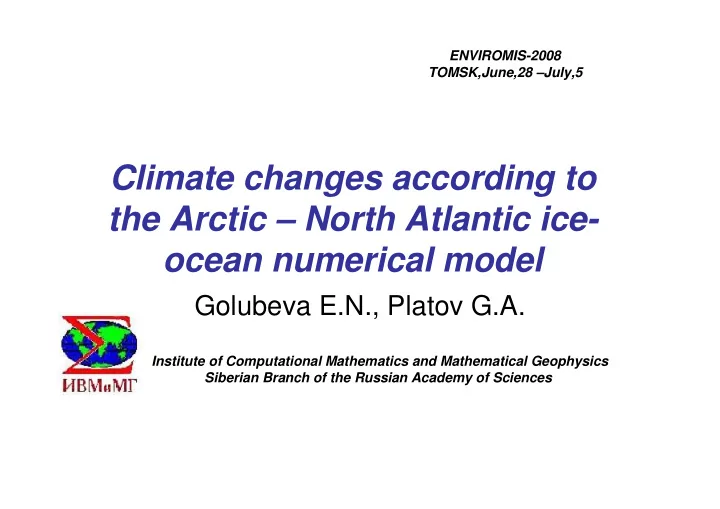

ENVIROMIS-2008 TOMSK,June,28 –July,5 Climate changes according to the Arctic – North Atlantic ice- ocean numerical model Golubeva E.N., Platov G.A. Institute of Computational Mathematics and Mathematical Geophysics Siberian Branch of the Russian Academy of Sciences
Objectives • To reproduce the climate changes in the Arctic and North Atlantic in the 1948- present on the basis of the numerical coupled ice-ocean model and with the use of reanalysis NCEP / NCAR data A schematic drawing of North Atlantic and Arctic • To investigate the role Ocean circulation. Red arrows represent relatively warm water from of atmospheric forcing lower latitudes entering the Arctic, while blue arrows represent the export of colder water from the Arctic.Shaded in controlling the white shows the average area covered by sea ice. (Figure courtesy of G. Holloway, Institute of Ocean ocean circulation Sciences, Sidney, British Columbia).
Coupled Ice-Ocean Model 3D Ocean Circulation Model of ICMMG based on z-level vertical coordinate approach (Kuzin1982, Golubeva at al.,1992, Golubeva,[2001], Golubeva and Platov,[2007]) • Conservation laws for heat, salt and momentum with Boussinesq, hydrostatic and ‘rigid lid’ approximations • Separation of the external and internal mode in momentum equations • Barotropic momentum equations are expressed in term of stream function • QUICKEST (Leonard,[1992]) is used in the latest model version for the T-S advection. • Two versions of mixed layer parameterization: - Vertical adjustment based on the Richardson number - Vertical diffusion coefficient based on the stable solution of turbulent energy equation Ice model-CICE 3.0 (elastic-viscous-plastic) W.D.Hibler ,1979, E.C.Hunke, J.K.Dukowicz,1997, G.A.Maykut 1971 C.M.Bitz, W.H.Lipscomb 1999,J.K.Dukowicz, J.R.Baumgardner 2000, W.H.Lipscomb, E.C.Hunke 2004
1948-2007 model run The characteristics of the lower atmosphere and radiation are prescribed, taken from the NCEP/NCAR reanalysis (Kalnay et al., [1996]) and CIAF ( Large and Yager[2004]) . As initial condition for temperature and salinity , the winter season distribution was taken from PHC (Steele et al., [2000]) data set. The initial ice distribution was prescribed as ice of 2 m thickness and 0.9 compactnes in the areas of the negative lower atmosphere temperature. Seven years of spin-up run provide a more reasonable sea ice distribution, which is further used as initial sea ice state.
A leading pattern of weather and climate variability over the Northern Hemisphere is the North Atlantic Oscillation , which refers to a redistribution of atmospheric mass between the Arctic and the subtropical Atlantic Positive phase Negative phase www.ldeo.columbia.edu/NAO by Martin Visbeck
Two main regimes of the Arctic’s ice drift and surface circulation Previous investigation - Gudkovich(1961), Nikiforov and Shpaiker(1980), Proshutinky and Johnson,1997 and others . Model results Anticyclonic regime Cyclonic regime 1960,1961,1963,1965,1966,1969, 1970-1973,1977-1980,1982-1983, 1967,1968,1981,1984,1989,1993,1995, 1985-1986, 1988, 1992,1994, 1996, 1997,1999,2000,2002,2003 1998,2001
Atlantic Water circulation in the intermediate layer 200-1000 m (following Rudels et al/.[1994])
According to the investigations [ J.H. Swift, K. Aagaard, L. Timokhov, and Ev.G. Nikiforov , 2004] , based on the enhanced version of the 1948-1993 data EWG ( Gore-Chernomyrdin environmental bilateral agreement, Environmental Working Group,1997), there were some warm and cold events in the Atlantic layer of the Arctic Ocean during this period Period HYPOTHESIS 1955- Warm The phase propagation of the warm period anomaly of the end of 1950-s is consistent with a Fram Strait origin 1963 -1969 Warm enhanced horizontal heat period advection and reduced vertical heat loss associated with increased upper-ocean stratification. 1974- Cold period enhanced cooling of the Atlantic the end of waters entering the Arctic Ocean via the 1980-s Barents and Kara seas 1989-1993 Warm The phase propagation of the strong period warm anomaly of the early 1990s is consistent with a Fram Strait origin
NAO INDEX Temperature vertical distribution at the selected points
Ice velocity distribution Surface salinity 1960 1963
Surface salinity Temperature at the depth of 200m Cold Warm
NAO INDEX Temperature vertical distribution at the selected points. Cold period
Warm period Cold period Temperature distribution at the depth of 200 m Ice velocity distribution
NAO INDEX Temperature vertical distribution at the selected points. Warm period
Temperature at the depth 200 m
Velocity distribution at the depth of 200 м . 1960 - 1974 1990-1995
Ice thickness distribution during the model run
Summer ice thickness in 2005 and 2007 (model run)
Recommend
More recommend